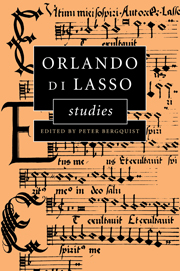Book contents
- Frontmatter
- Contents
- Preface
- List of abbreviations
- 1 Aspects of form in Orlando di Lasso's Magnificat settings
- 2 Orlando di Lasso and Andrea Gabrieli: two motets and their masses in a Munich choir book from 1564–65
- 3 Post-Tridentine liturgical change and functional music: Lasso's cycle of polyphonic Latin hymns
- 4 The salon as marketplace in the 1550s: patrons and collectors of Lasso's secular music
- 5 Lasso's “Standomi un giorno” and the canzone in the mid-sixteenth century
- 6 Lasso's “Fertur in conviviis”: on the history of its text and transmission
- 7 Orlando di Lasso and Rome: personal contacts and musical influences
- 8 Orlando di Lasso as a model for composition as seen in the three-voice motets of Jean de Castro
- 9 The madrigal book of Jean Turnhout (1589) and its relationship to Lasso
- 10 Modal ordering within Orlando di Lasso's publications
- 11 Correct and incorrect accentuation in Lasso's music: on the implied dependence on the text in classical vocal polyphony
- General index
- Index of Lasso compositions and printed sources
1 - Aspects of form in Orlando di Lasso's Magnificat settings
Published online by Cambridge University Press: 18 December 2009
- Frontmatter
- Contents
- Preface
- List of abbreviations
- 1 Aspects of form in Orlando di Lasso's Magnificat settings
- 2 Orlando di Lasso and Andrea Gabrieli: two motets and their masses in a Munich choir book from 1564–65
- 3 Post-Tridentine liturgical change and functional music: Lasso's cycle of polyphonic Latin hymns
- 4 The salon as marketplace in the 1550s: patrons and collectors of Lasso's secular music
- 5 Lasso's “Standomi un giorno” and the canzone in the mid-sixteenth century
- 6 Lasso's “Fertur in conviviis”: on the history of its text and transmission
- 7 Orlando di Lasso and Rome: personal contacts and musical influences
- 8 Orlando di Lasso as a model for composition as seen in the three-voice motets of Jean de Castro
- 9 The madrigal book of Jean Turnhout (1589) and its relationship to Lasso
- 10 Modal ordering within Orlando di Lasso's publications
- 11 Correct and incorrect accentuation in Lasso's music: on the implied dependence on the text in classical vocal polyphony
- General index
- Index of Lasso compositions and printed sources
Summary
The fundamental, text-generated contour of polyphonic Magnificat settings in the late sixteenth century, familiar to most students of that era's music, has recently been outlined in the first chapter of David Crook's exemplary new study of Lasso's Magnificats. However, since virtually all vocal music ultimately takes its form from its text, and since form is the topic of this essay, it may be useful to review that contour before going into the specifics of form itself.
The Magnificat is the closing element at Vespers, belonging to the species of ritual lyrics of scriptural origin known in the Roman rite as “canticles.” These lyrical texts, which resemble psalms in their devotional, often ecstatic, tone, also resemble psalms in having individual verses of bipartite structure–that is, each verse has two parts, generally of parallel or appositive content. Though these two parts are often of unequal length, it is customary for the sake of brevity to refer to them as “halves.” The text of the Magnificat comes from Luke 1: 46–55. To these ten verses of Scripture are added, in liturgical use, the two verses of the standardized Lesser Doxology (“Gloria Patri et Filio…et in saecula saeculorum. Amen”), so that the text of the sixteenth-century Magnificat has, in all, twelve verses.
At Vespers on any given day an antiphon proper to the day is sung before the chanting of the Magnificat, and again after it.
- Type
- Chapter
- Information
- Orlando di Lasso Studies , pp. 1 - 19Publisher: Cambridge University PressPrint publication year: 1999



